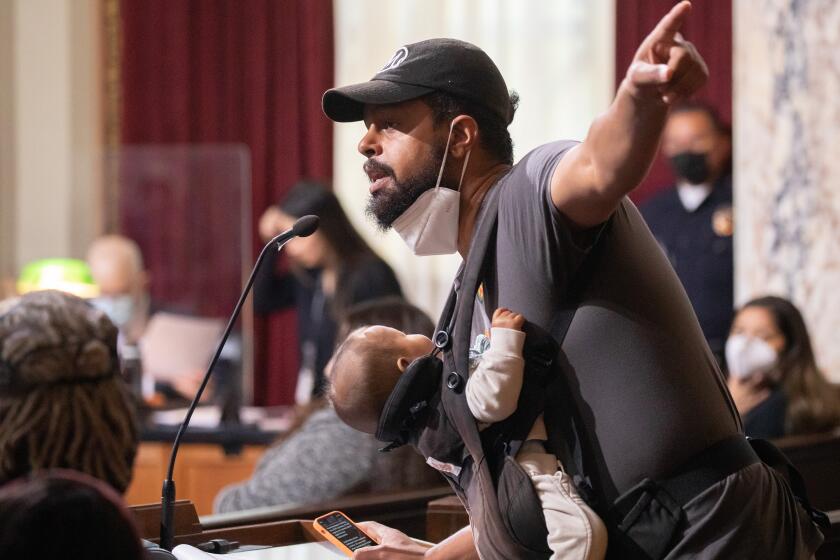Drilling Plan Sparks Coast Battle Cry
Caught unaware by a political compromise that would open 54 square miles of Orange County coastal waters to oil exploration, coastal community leaders vowed Tuesday to rally widespread opposition to the plan.
“Laguna (Beach) and Newport (Beach) have taken it right in the belly,” Laguna Beach City Councilman Robert F. Gentry said Tuesday.
“These six tracts are about six to eight miles from the beach and would support up to a dozen oil rigs. They’re right in the heavy boating traffic lanes between Newport and Dana Point harbors and Santa Catalina Island. . . . ,” Gentry said.
“And these six tracts are very near, if not on, the Newport-Inglewood fault line.”
At Gentry’s request, the Laguna Beach council Tuesday night decided to mount a public campaign to combat the opening of the six previously excluded offshore tracts by means of the compromise unveiled earlier in Washington. Each tract comprises nine square miles.
“This comes as a complete surprise,” Newport Beach City Councilwoman Evelyn Hart said of the compromise. “We thought it looked very secure to keep a moratorium on the entire area . . . . We had no idea anything like this was going to happen.”
Hart said she will ask the Newport Beach council to reaffirm its opposition to offshore oil drilling except in the event of a national emergency. Newport Beach for years has battled against any drilling, at times in federal court.
The compromise, crafted by members of California’s congressional delegation and the U.S. Department of the Interior, was intended to protect the bulk of California’s coastal waters from oil exploration through the year 2000.
The proposal would open for leasing about 1,300 square miles of ocean floor in federal waters off the California coast in exchange for protecting through the year 2000 the remaining 57,000 square miles now barred from oil company exploration by a congressional moratorium.
The proposed offshore tracts include about 1,000 square miles of ocean floor off Northern and Central California, and about 300 square miles off Orange, Los Angeles and San Diego counties.
Rep. Robert Badham (R-Newport Beach) said Tuesday that he has opposed the compromise plan since it cropped up a few weeks ago. The original compromise proposed the lease of 18 tracts off Orange County, he said.
“It’s a bad idea,” Badham said. He said he was unable to support even the final compromise on six Orange County area tracts, as the California congressional delegation had wanted.
“I am opposed to this, and I felt that the best position I could maintain for the people I represent is not in any way to be a part of any deal that was struck compromising my whole district,” he said.
Badham said that Orange County communities may have no recourse but to fight the awarding of those leases in court.
The House Appropriations Committee included the tentative agreement Tuesday in the U.S. Department of the Interior’s fiscal 1986 spending bill, which will come up for a vote after the summer recess. Public comment on the plan will be sought for a month.
The proposal also would be subject to environmental review by state and local agencies.
Bill Grant, director of the Pacific region of the Interior Department’s minerals management service, said that there are now four platforms on the five tracts leased to oil companies in federal waters off the Huntington Beach-Long Beach area.
He said that there are roughly the same number of rigs in the three-mile strip of state-governed waters off Huntington Beach.
The five federal tracts, leased for a total of $171 million in 1975, now produce 16,700 barrels daily, Grant said. “That is a significant value for the nation and for the oil companies,” he said.
Danger Too Great
Gentry and Hart, who represent their coastal cities on the offshore oil lease issue as part of in a coalition group of local governments and developers, said that the potential for environmental damage is too great to permit any further drilling.
“Being that close to shore, we have some real concerns about air quality because those rigs are driven by diesel engines that run 24 hours a day,” Gentry said. “We have an onshore flow of air that would bring the pollutants from the oil rigs by air into the basin.
“We’re also facing what we’re told is a period of severe threat of seismic activity, and if that fault line is involved in a major earthquake, I don’t know what that would mean for Laguna Beach. If there is a major spill, the City of Laguna Beach would have to manually clean all its own beaches.”
Grant of the Interior Department said that the safety record of drilling in federal waters on the outer continental shelf has been very good. He said that oil rigs, like onshore buildings built in areas of seismic activity, are built to withstand severe quakes.
Hart was equally concerned about the visual impact of having towering oil platforms dotting the coastal horizon.
“You know, a member of the Department of the Interior said a few years ago that Newport Beach has one of the most beautiful coastlines in the United States and that one of the reasons is because they don’t have any offshore oil drilling platforms,” Hart said Tuesday.
Million of Tourists
“It’s important that we keep our beaches clean. Newport Beach alone entertains well over 10 million beach tourists each year. . . . I’m going to ask our council to reaffirm our past position on this issue and to ask for a reversal of this decision.
“We are very serious about protecting our coastline.”
The Laguna Beach City Council approved an action plan Tuesday night that included meeting with representatives from coastal cities from Carlsbad and Oceanside north to Los Angeles to discuss joining forces to oppose the lifting of the moratorium on Southern California tracts.
Members were assigned to meet with such groups as the Sierra Club, real estate boards and the Orange County Chamber of Commerce to organize a letter-writing campaign opposing the opening of the six tracts.
They also planned to meet with a coalition of cities and developers, including the Stein-Brief Group and the Irvine Co., both of which have substantial coastal properties planned for development. No timetable was set for their actions.
More to Read
Start your day right
Sign up for Essential California for news, features and recommendations from the L.A. Times and beyond in your inbox six days a week.
You may occasionally receive promotional content from the Los Angeles Times.






